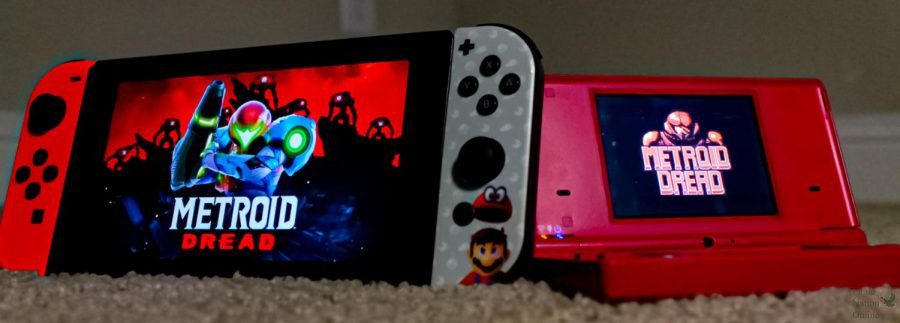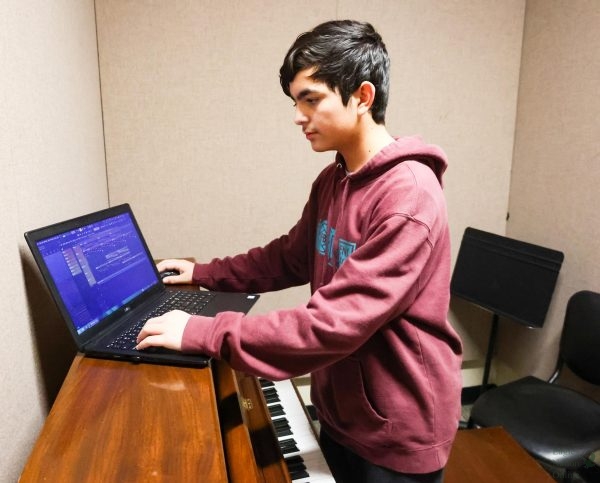Column: ‘Metroid Dread’ – Nintendo resurrects cancelled game 15 years later
Metroid Dread has changed it’s home from the Nintendo DS to the far newer Nintendo Switch. The ‘Metroid’ series’ new sequel, ‘Metroid Dread’ will finally be released on October 8, 2021, 19 years after the last Metroid game, ‘Metroid Fusion’ on the Game Boy Advance, released in 2002.
The mainline “Metroid” series has been a classic since 1986, including the legendary “Super Metroid” and the original Metroid on the NES, an abbreviation for the Nintendo Entertainment System. Despite the cult following and critical praise, there has not been a new mainline 2D Metroid game since the release of Metroid Fusion for the Game Boy Advance in 2002, 19 years ago. That is, until just recently.
Nintendo announced Metroid Dread for the Nintendo Switch during this year’s E3, the yearly Electronics Entertainment Expo. However, even though Nintendo unveiled the game this year, this is not a new game — and it’s far from it. In fact, Metroid Dread has spent the last 15 years in ‘development hell’ — a term used in gaming when a game has spent an extremely long time in development. There is so much to the development of this game and what it went through to get on store shelves, and it’s a miracle that we finally get to experience it. This is the story of Metroid Dread.
For those who are unaware, the Metroid series follows the famous intergalactic bounty hunter Samus Aran. The Galactic Federation hired her to exterminate the Metroids, a parasitic floating life form created by the military as a bio-weapon, now being enslaved by the evil Mother Brain. Metroid Dread is the conclusion to a 30-year-long five-part story; all served to us in those sweet, sweet 3D graphics never before seen in the mainline Metroid series — besides “Metroid: Samus Returns,” a remake of Metroid II for the Nintendo 3DS.
In the beginning, Yoshio Sakamoto, the Senior Officer of Nintendo EPD and producer of the Metroid series, joined his team at Nintendo Research and Development 1, now known as Nintendo EPD, to come up with the idea for Metroid Dread around 15 years ago, at the time of this publication. The developers originally intended the game for the Nintendo DS. An official Nintendo YouTube video with the producer shares some inside details about the development of the game, and states that the team had some good ideas, but they felt that the technology present at the time couldn’t portray their idea properly. So, they scrapped the game.
Technical Limits Foil Sakamoto’s Plans
“Actually, the idea for Metroid Dread first came up about 15 years ago. However, we gave up on the idea at the time because we felt the technology back then just couldn’t properly bring the concept to life.” -Yoshio Sakamoto
Not much is known about the original DS game. IGN reported that the game was “thought to be a traditional 2D sequel in the Metroid franchise designed specifically for [Nintendo DS],” similar to how we know Metroid Dread today. But, that is all the information the fans had in the beginning: a name, and that it was on the DS. At this point, the game didn’t even enter pre-production before the team scrapped it.
Unfortunately for Nintendo, they had already released information about Metroid Dread to the media before Nintendo discarded the game. According to Wired, “Nintendo first announced this game to the media before E3 2006. Then it disappeared forever.” The game also appeared on an internal Nintendo upcoming game list grabbed by IGN.
IGN Makes a Discovery
“In 2005, IGN got hold of an official internal Nintendo software list that revealed a number of key DS games set to be announced in the future. All of the games on the list . . . were eventually announced and released. All, that is, except for one — a project known simply as Metroid Dread.” IGN
No one knows why or how Metroid Dread got onto this list, but Nintendo quickly removed the title from their list of upcoming games, seeming to hope that no one would notice. But, they did. Metroid Dread never made an appearance at E3 in 2005, or any E3 for that matter. Nintendo then denied the existence of this game, because it never really did exist.
Nintendo Denies the Game’s Existence
“Metroid Dread appeared and then quickly disappeared on Nintendo title plan lists and in magazine articles in time for E3 2005. Nintendo would later decline comment on the title, keeping to itself whether its original listing was somehow an error or what development state the title is/was in, or whether or not the game still exists. No screenshot or further confirmation of the game has been released, then or since. Should we still prepare ourselves for the arrival Dread? At the moment, only Nintendo knows…” IGN
At this point, fans were left confused with no real information on this game’s existence. Real? Fake? Canceled? Still in development? No one knew. Until, on one fateful day in 2007, something big was revealed.
On August 27, 2007, Nintendo released “Metroid Prime 3: Corruption” on the Nintendo Wii, to critical acclaim. Reviews of the game were great, but why this game is so important to this story is one tiny easter egg left in by a developer at Retro Studios, the ones who made Metroid Prime 3. Using the “scanning” mechanic in a certain area in the game, you will get the following message:
“Experiment status report update: Metroid project ‘Dread’ is nearing the final stages of completion.” “Metroid Prime 3: Corruption”
This tiny, commonly overlooked message tells something big about Metroid Dread. This is real, official proof that Metroid Dread actually existed at some point, and it wasn’t just a rumor. Not only that, but this also conveys that Nintendo allowed Retro Studios to leave in this tiny easter egg. This small gesture invoked hope in the fans who were still waiting patiently for a new mainline Metroid game.
Shortly after the release of Metroid Prime 3, development on Metroid Dread started up again around 2008, according to Video Game Researcher Liam Robertson on his YouTube video discussing the development history and secrets of the Metroid series. Mr. Sakamoto later confirmed this in the official Nintendo YouTube video discussing the matter.
Second Attempt Foiled Once Again
“We did have a chance to try again after that, but we felt like we still couldn’t create the game as originally imagined, so we ceased development again at that point.” Yoshio Sakamoto
Much more of the game was made during the second attempt, including a prototype and a full premise. According to Mr. Robinson’s YouTube video, Nintendo staff members were invited to see an early prototype of the game behind closed doors. In another YouTube video featuring Liam Robinson, Robinson said that the prototype featured the top screen with the normal sprite work you would see in any normal Metroid game, and the bottom screen showed the map. It featured an art style very similar to Metroid Fusion. One person that Mr. Robinson spoke to about the matter even went so far as to say that it, “literally looked like a port of fusion on DS.”
“Metroid: Samus Returns” on the 3DS re-used the dual-screen setup seen in this prototype. During an email interview with GameRant, Yoshio Sakamoto highlights Metroid: Samus Returns with its use of a brand-new user interface designed specifically for the 3DS, and why they went with the 3DS instead of the brand-new Nintendo Switch at the time.
Old DS User Interface Concept Comes Back for 3DS
“One of the themes we chose to stick with this time [with ‘Metroid: Samus Returns’] was utilizing both 3D visuals and a dual screen setup. In fact, I’d been interested in creating a Metroid title that allowed you [to] display the map constantly on a second screen and interact with the elements of the UI by touching them since the time of the original DS.” Yoshio Sakamoto
It is extremely likely Sakamoto is referring to Metroid Dread when he talks about the DS. This control scheme seems really appealing to the Metroid series, and I’m surprised that Nintendo didn’t use this new user interface more. This also indirectly verifies the information about the prototype from the people who saw it first-hand.
Another source on this version of the game is IGN c0-founder Craig Harris, who when prompted on Episode 75 of the Nintendo Voice Chat podcast, had this to say:
Craig Harris Sheds Light
“Well they still have Metroid Dread, at least the script for it. I bring it up every single time, and they do have the story. I saw the synopsis of the game, and I know it exists, but they pulled the plug at the very last minute . . . and I know they can always bring it back” Craig Harris
This confirms that the second attempt of the game did feature a story, although he doesn’t remember anything about it.
After Nintendo swept this attempt of the game under the rug, a long period of silence about the game commenced. No new real information came out about the game beyond this point, and no one brought any new rumors to the table. Metroid Dread faded into obscurity and was written off as yet another Nintendo game that we will never play.
In a 2010 interview with NintendoLife, Sakamoto confirmed the existence of the game to the public for the first time. He also stated that he still wants to make this game happen, and wants to restart the game completely from scratch.
Sakamoto Confirms The Game’s Existence
“I cannot deny the existence of such a project in the past but cannot say if it will be what I move onto next or not. I’m sorry but we would like to keep that game a mystery. After all, there has been a lot of speculation surrounding Dread. And my hope, if at all possible, is to reset the situation at once and start from scratch.” Yoshio Sakamoto
Little did he know that his dream would come true later, because of one significant entity. Mercury Steam Entertainment S.L., the hero of this story, is a Spanish game development company based in San Sebastián de Los Reyes, Madrid, Spain. Their previous work includes three games in the popular Castlevania series owned by Konami, which has a very similar gameplay style to Metroid; to the point where fans include the two series as the parents of an entire sub-genre of games known as, “Metroidvania.”
Nintendo hired MercurySteam to co-develop “Metroid: Samus Returns” with Nintendo EPD. MercurySteam impressed Sakamoto greatly with their talent at making these types of games.
Sakamoto Blown Away
“I honestly thought we’d have no choice but to abandon the concept, but then we met Mercury Steam Entertainment, with whom we co-developed “Metroid: Samus Returns” for Nintendo 3DS. They’re extremely talented. Technically, they’re very skilled. They also have great taste. But more than anything, they have an incredible understanding of Metroid games.” Yoshio Sakamoto
Because of how well they did, Sakamoto entrusted them to help finally make Metroid Dread as they originally intended, if not better.
All the Pieces Fall Into Place
“I was confident that teaming up with this wonderful team would finally allow us to bring Metroid Dread to life. And the result is that we’ve completed a version of Metroid Dread that even surpasses what we imagined 15 years ago.” Yoshio Sakamoto
The rest is history. Fast forward to June 15, and Metroid Dread is finally announced for an Oct. 8 release date, after all this time. This 15 year-long story has reached its satisfying conclusion. Was Metroid Dread worth the wait? We’ll just have to wait for its release in October to find out.
Editor’s Note: This article was updated Sept. 24. for AP Style.
Your donation will support the student journalists of Prosper High School. Your contribution will allow us to purchase equipment and cover our annual website hosting costs.
















John Adam • Oct 30, 2021 at 5:55 am
I’ve been playing Metroid since NES. I would be more excited about this game but I’m not crazy about the art design. It just doesn’t give me the heebie-jeebies as Super Metroid did. Also, I really wish I didn’t have to play Nintendo flagships on their shitty hardware. I’m definitely going to play it though. http://www.xfire.com says It’s a lot of fun. The emmi sections are pretty annoying though